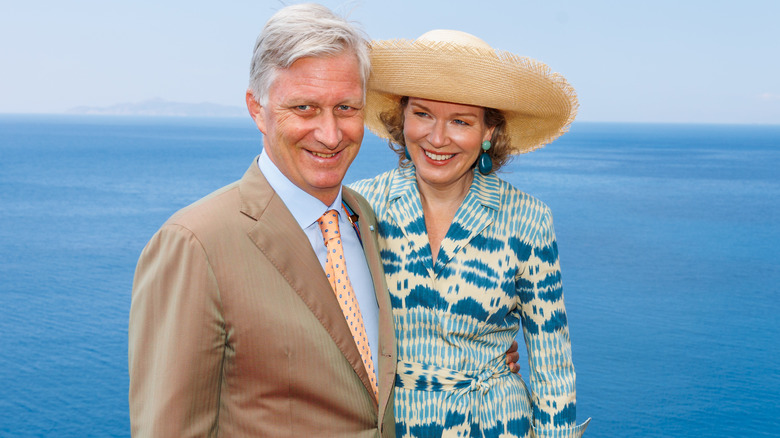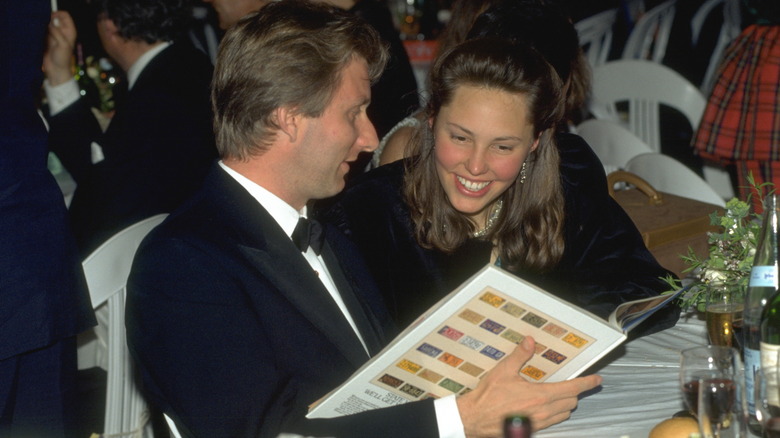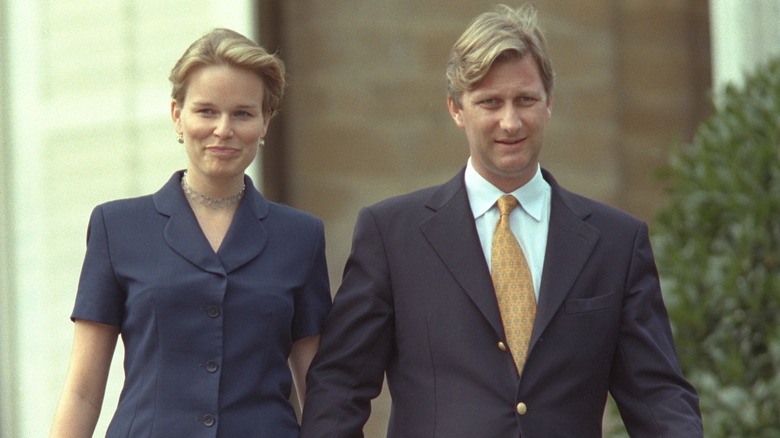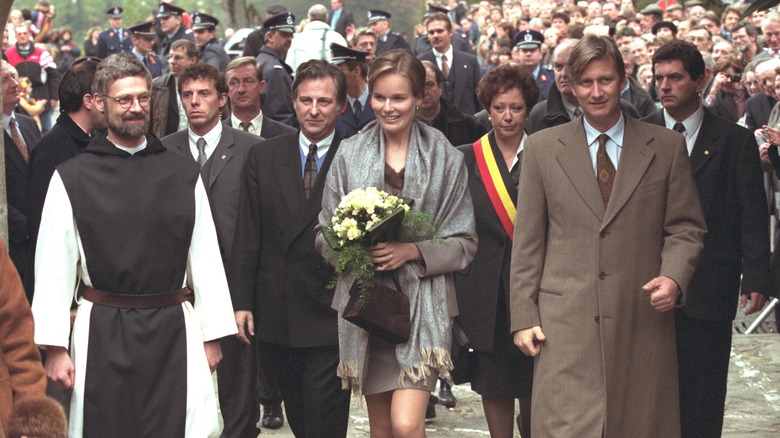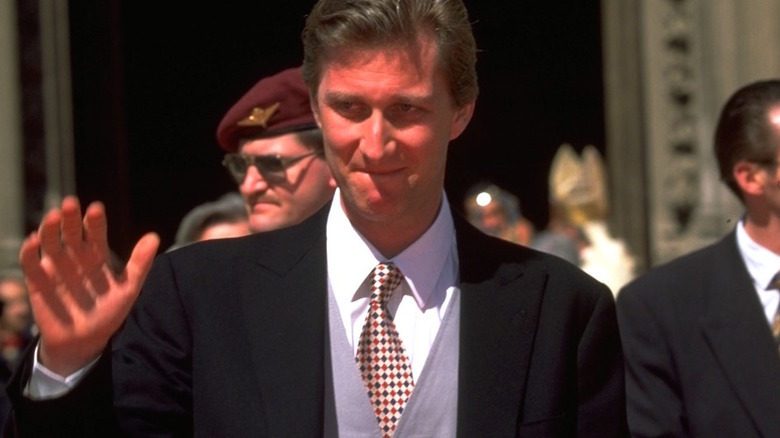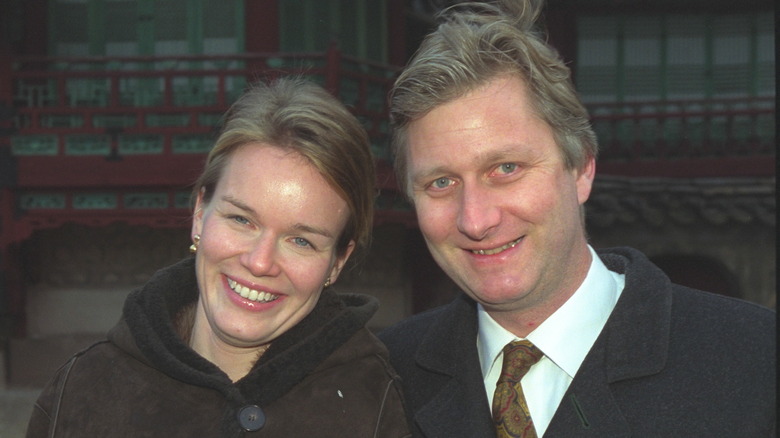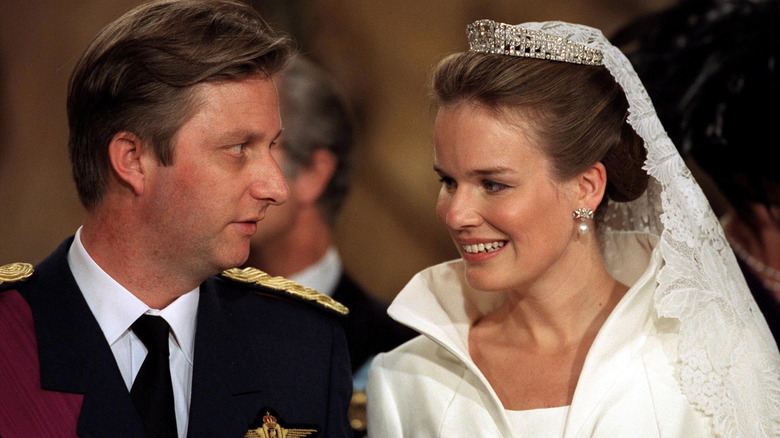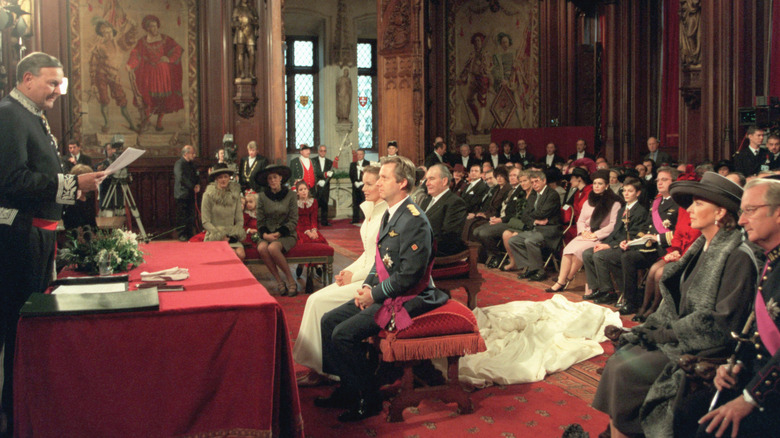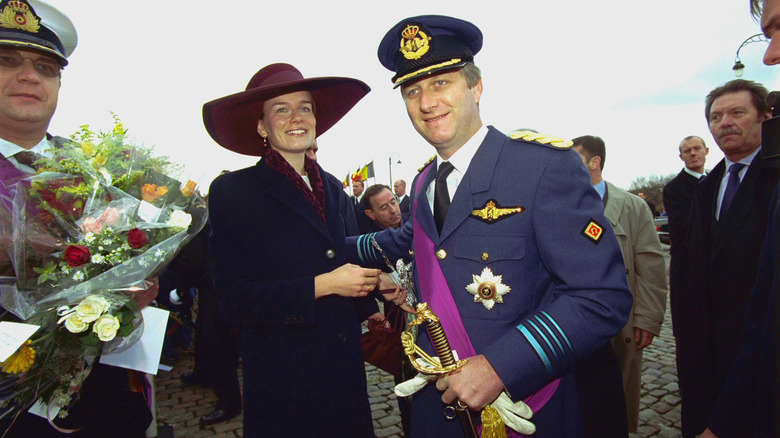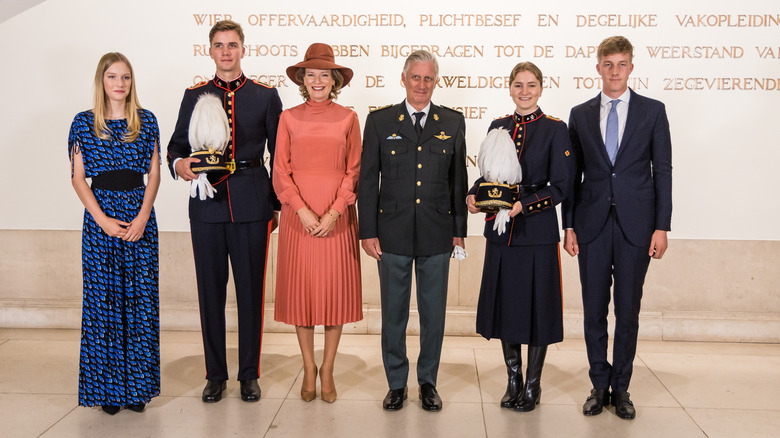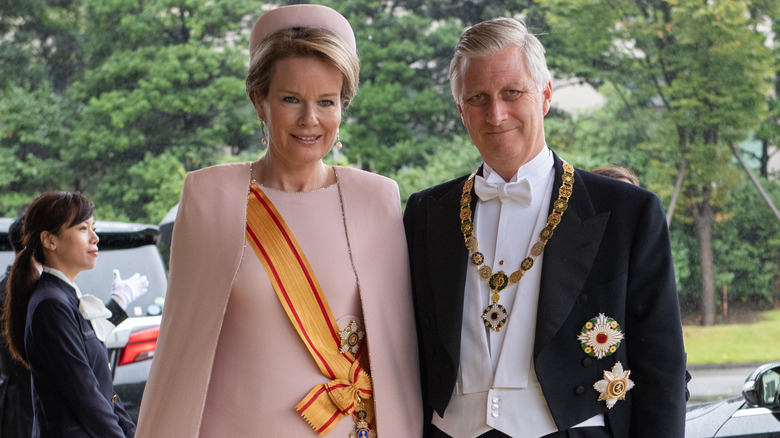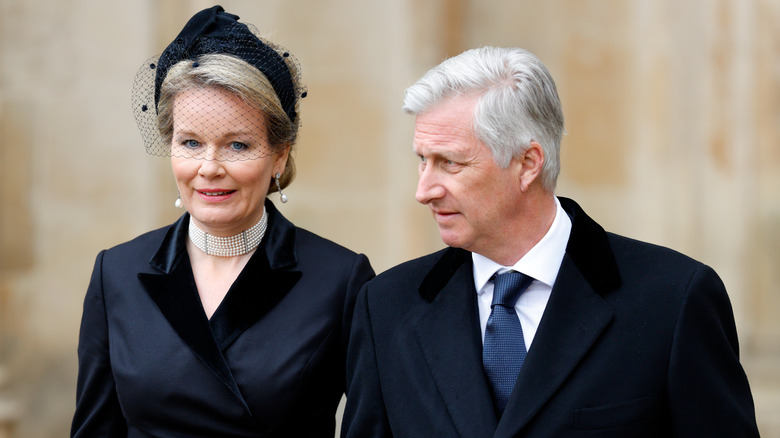Inside King Philippe's Relationship With Queen Mathilde
Belgium's King Philippe and Queen Mathilde married in 1999 and have succeeded in the tricky task of keeping their private lives private while carrying out all the public obligations required of working royals. One factor that may have helped them is King Philippe's low-key (and what some critics call "dull") personality. Even in his younger, single years, he was more likely to be spotted on a long-distance bike ride than drinking and flirting in clubs. And unlike many royals, he hasn't left behind a string of high-profile ex-girlfriends. Indeed, his apparent absence of a love life had caused some royal watchers to worry that he'd never get married at all.
So when he finally did announce his engagement, it was the fact of his engagement, rather than his choice of a bride, that got people talking. His fiancée, Mathilde d'Udekem d'Acoz, while more outgoing than her now-husband, was also used to keeping a low profile — so much so that media outlets struggled to find any recent photos of her when their engagement was announced. A Belgian noble herself, she is the country's first queen to be an actual native Belgian — a fact that only endeared her to the Belgian public more.
The queen had an established career before they were married
Even though Queen Mathilde came from a noble family (her mother is a Polish countess and her Belgian-born father also has aristocratic roots) and ran in the same social circles as the royal family, she saw herself as more than just a socialite born with a silver spoon in her mouth. Instead, she pursued her university studies, then opened and ran her own practice in Brussels as a speech therapist before getting married. During her practice, she pursued additional studies in psychology.
Her interest in language and speech seems appropriate for someone taking on the role of a spokesperson for life in a multinational, multiethnic country. She is fluent in both of Belgium's major languages (Dutch and French) as well as in English and Italian. And while she's no longer in a position to coach her subjects through their speech, she's managed to channel her interests into her charitable work, which focuses largely on education and teaching.
They kept their romance under wraps for three years
For many of us, following the ups and downs of royal romances is a guilty pleasure — and there are plenty of media outlets happy to satisfy our craving with invasive, innuendo-filled coverage of royal couples' every move. This, of course, is anything but a pleasure for the royals themselves, as Prince Harry revealed in detail in his memoir "Spare" which is largely a book-length screed on the toxicity of Britain's tabloid press.
Then-Prince Philippe and his new love interest Mathilde d'Udekem d'Acoz were well aware of the potential pitfalls of making their new relationship public — so they didn't. Somehow — it's unclear how — they managed to keep their courtship completely out of the public eye for the three years leading up to their engagement. And when they decided to take the plunge and get married, soon-to-be Princess Mathilde understood how radically her life would change. Perhaps because of this, the couple spent the days leading up to their official engagement announcement enjoying each other's company in a secret location.
Their engagement completely blindsided the Belgian media
For professional purveyors of gossip, nothing stings worse than getting scooped on a good story. So when Belgium's royal family announced that then-Prince Philippe was engaged, jaws across the country dropped and reporters were in shock. How could they have possibly missed a royal romance that had been going on right under their noses for three years?
But frustrated as they were, thankfully, they did not take out their frustrations on the newly public couple. It helped that the princess-to-be provided nearly zero fodder for gossip. Out of all the glamorous, high-profile women Philippe could have fallen for — Belgium's previous kings had all married women from other European countries — he chose a cheerful, grounded Belgian-born speech therapist whom his compatriots took to immediately. Even better, her deep roots in both the Dutch-speaking north and French-speaking south of the country made her universally relatable — a nearly impossible task in a country whose two regions can barely tolerate each other. "She's perfect! She's the Bionic Princess!" University of Liege historian Francis Balace told The Washington Post.
Rumored to be gay, King Philippe fought off reports their marriage was arranged
Gossipers gotta gossip. So even though the romance between then-Prince Philippe and Mathilde d'Udekem d'Acoz was a low-drama affair, and there's absolutely nothing strange or surprising about two single people of noble descent finding and marrying each other, some royal watchers couldn't help finding the whole thing a bit fishy. For one, Philippe was known to be a bit shy and socially awkward, and not known for having much of a love life, if any at all. His lack of a love life led to rumors he was gay, and these rumors led to speculation that the prince's engagement was a bit too perfect. How could this guy, of all people, win over a woman who was not only smart, charming, and attractive, but had the perfect cultural and linguistic pedigree to unite the bilingual, bicultural country? Surely, the whole thing must have been arranged by the royal household.
Philippe firmly denied these allegations. "I saw her [Mathilde] from far, and I went to talk to her. I knew right away that she would be my future wife," he said in a French-language interview with the Belgian broadcaster RTBF (via the Daily Mail).
She overhead discussions of her engagement in a bookstore – and slipped out unnoticed
For some people, the idea of marrying a prince is a cherished fantasy. But the rare few for whom this fantasy becomes a reality know that royal life means significant burdens as well as privileges. As a walking, talking symbol of your country, your life and your choices are no longer truly your own. And good luck trying to enjoy any privacy outside of the home — your every move will be scrutinized and documented.
When she accepted then-Prince Philippe's proposal, soon-to-be Princess Mathilde understood what lay ahead, and spent the last few days before their public engagement announcement savoring her final days of freedom as an ordinary citizen. "The rumors started about me on Friday, three days before the official presentation," she said in an interview with RTBF. "But no one had a photo or anything yet. Me, feeling that I shouldn't stay in places where I could be identified, you know my love of books? Well, I went to a bookstore. I [sic] heard the 'Journal Parlé' on the radio, in the bookstore, talking about the possible engagement of Prince Philippe and I was reading." Her lack of a photo record served her well — she managed to continue browsing and slip out of the bookstore unrecognized.
Their wedding was attended by royalty from around the world
Both serious royal watchers and ordinary Belgian citizens eagerly awaited the December 1999 wedding of their crown prince. It would represent a symbolic turnaround for the royal family. The previous king, King Baudouin, had died childless, leaving the throne to his brother (King Philippe's father), who became King Albert II. The fact that then-Prince Philippe had been approaching 40 with no romantic prospects in sight raised yet more concerns about the royal line of succession. In addition, it would be the last royal wedding of the 20th century, which was as good an excuse for celebration as any.
The wedding did not disappoint. All the bling and pageantry one would expect of a royal wedding were on display. The future Queen Mathilde entered the ceremony in a silk crepe coatdress with a 15-foot train, along with a century-old vintage veil of Belgian lace and an antique diamond tiara belonging to the royal family. The large procession of wedding attendants came dressed in Christmasy red velvet. Of course, no royal wedding would be complete without a long roster of royal guests. Among the royals in attendance were Britain's King Charles III, Prince Albert of Monaco, Crown Prince Felipe of Spain, King Harald of Norway, and Queen Beatrix of the Netherlands.
They asked their wedding guests for charitable donations instead of gifts
From the moment their engagement became public, King Philippe and Queen Mathilde made it clear they didn't intend to be just another stuffy, distant royal couple. Mathilde set the tone at their first public photo opportunity, where she wore down-to-earth beige slacks. While their wedding had all the luxurious trappings one would expect (the post-ceremony luncheon featured lobster, venison, and chocolate cake), extravagant gifts were nowhere to be found. This was at the couple's request: They asked guests for charitable donations to support vulnerable populations.
The couple obviously didn't need more stuff, and it freed guests from the vexing matter of trying to decide what to get people who already had everything. It also set the tone for their future philanthropic work. As a working royal, Queen Mathilde has focused on supporting vulnerable populations such as children and those living in poverty. Youth empowerment is another theme in the queen's work as she works to help young adults who are aging out of foster care get the support they need to transition smoothly to adult life. In addition, the Queen Mathilde Fund supports initiatives proposed by young people to help other youth.
They have jointly engaged with difficult truths about Belgium's history
Most modern royals no longer have absolute governing or decision-making power. In Belgium, for instance, the king's role is largely advisory. As the royal office's website explains, "In the political domain, the King's action does not consist in exercising personal power without the cooperation of ministers. The King interacts with players in the political arena by asking questions, expressing opinions, making suggestions, warning and giving encouragement."
None of this would do any good, however, if the king lacked the moral authority to be taken seriously. No matter how limited their powers, much of the public still sees royals as symbols of everything their countries stand for — the good, the bad, and the ugly. Belgium, like many European countries, has an ugly history of colonialism that continues to haunt its international reputation. Its domination of what is now the Democratic Republic of Congo was brutal even by the standards of the time — around 10 million people are thought to have died from famine, disease, or outright murder after Belgium's King Leopold II took control of the country in the 1800s. It would have been easy for King Philippe and Queen Mathilde to sweep this under the rug, as did their predecessors, but instead, they visited Congo in 2020 and came clean, with King Philippe officially apologizing for the "suffering and humiliation" caused by his country (per Reuters).
They seek to give their four children a normal upbringing
Marrying into a royal family and being born into one are both difficult situations to navigate. At least those who marry royalty today mostly do so by choice. But being born into a royal family is no picnic either. "You have to abide by certain rules for which you never chose," Belgian historian Mark Van den Wijngaert explained to Politico. King Philippe knows this from personal experience. His parents had a difficult marriage and were often absent. "He [Philippe] has said a few times in the media in recent years that he did not have such a nice childhood," child psychiatrist Peter Adriaenssen told The Brussels Times.
He and Queen Mathilde had no intention of letting their children repeat this cycle. Instead, they strive to give them as normal a childhood as their roles allow and work to keep them out of the public eye, apart from planned appearances. When the Belgian press published photos of their son Prince Gabriel playing with friends, for instance, the royal family was outraged. Unremarkable and unrevealing as the photos were, the family considered them an invasion of their son's privacy. Prince Gabriel's college-age older sister, Princess Elisabeth, however, has been gradually making more public appearances with her parents, as they prepare her for her future role as queen.
Royal watchers say Queen Mathilde balances out King Philippe's social awkwardness
It's often said that opposites attract, and it's easy to see why this can be a good thing in a marriage — each partner can compensate for the other's weaknesses. For instance, the introvert can ensure the party animal doesn't go too wild, while the party animal can make sure the introvert enjoys a healthy social life. In the case of Belgium's King Philippe, royal watchers were charmed and relieved by his marriage to Queen Mathilde. They saw immediately that she brought to the table precisely what Philippe was conspicuously missing: charisma and a sense of ease when interacting with the public.
While Philippe has always taken his responsibilities seriously (he is said to have a deep understanding of Belgium's political and economic landscape), observers have long noted he never looked entirely comfortable or happy in the public eye. But from her first public appearance, Queen Mathilde's personality won over the public, and the results were tangible. Soon after their engagement was announced, the country's economic indicators picked up, and the country's feuding coalition government declared a truce — a moment of national optimism some called the "Mathilde effect" (per The Washington Post).
The couple strives to unify Belgium's feuding ethnic groups
Looking back on Belgium's long and distinctive history of arts and culture, from painters such as Bruegel and Rubens to Flemish tapestries and famed Trappist beers, it may seem hard to believe that Belgium has only been an independent nation since 1830. Moreover, it's a nation that's never been truly unified. The country's history has been largely defined by persistent conflicts between its two major ethnic and linguistic groups, the Dutch-speaking majority that occupies the northern part of the country, and the smaller population of French speakers to the south. The groups rarely intermingle voluntarily, and some French speakers have vocally advocated for annexing the country's Francophone region to France.
As the reigning monarchs over a divided nation, King Philippe and Queen Mathilde see one of their central responsibilities as honoring and unifying both communities. "I begin my reign with the will to serve all Belgians," the king said in a speech following his coronation in 2013 (via The Denver Post). "Belgium's strength lies in giving meaning to our diversity." Queen Mathilde herself is seen as embodying the unity her husband hopes to foster. She is fluent in both Dutch and French, and while her family's roots are in the north, she pursued her studies and pre-marriage career in the French-speaking south. The king founded the King Philippe Fund in 1998 to foster dialogue between the two communities and promote cultural interchanges between them.
